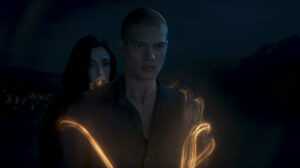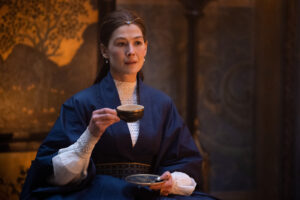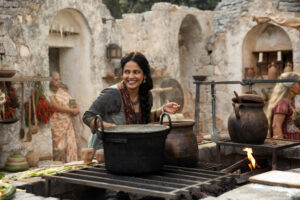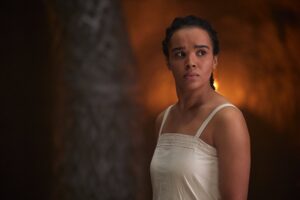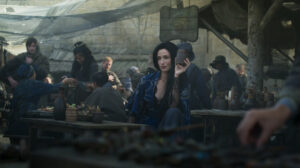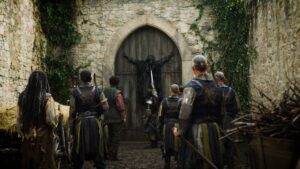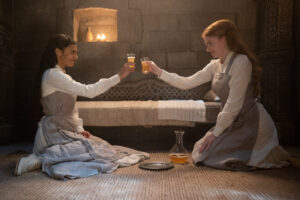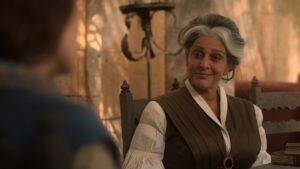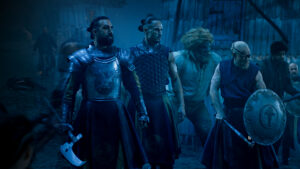MAJOR SPOILERS FOR THE WHEEL OF TIME SEASON TWO, EPISODES 1 – 5, AND BOOKS 1 – 3, AHEAD!
This piece was written during the 2023 SAG-AFTRA strike. Without the labor of the actors currently on strike, the series being covered here would not exist.
I’m not sure how Robert Jordan would feel about me describing his books as campy. But that’s beside the point. His books are campy, and delightfully so. The Eye Of The World, the first book in what would grow to become a fourteen-volume series spanning decades, was published in 1990, and hailed as a radical return to the classic formula that initially made high fantasy successful after a decade of the genre being dominated by weird, esoteric science-fantasy and grim, hypermasculine sword-and-sorcery, but far from being just another tired take on the hero’s quest, The Wheel Of Time is distinctly fun, right down to the iconic, endearingly garish cover of the first book that depicts Moiraine Damodred (Rosamund Pike) as a seemingly three-foot tall woman with a beehive updo sitting sidesaddle on a white pony, riding alongside a hulking samurai. It’s a colorful blend of the poetry and profundity of Tolkien and Le Guin’s seminal works, the vividly pulpy imagery of Brothers Hildebrandt artwork from the 70’s, and the wild romanticism of McCaffrey’s Dragonriders books, rolled up into the strongest, trippiest joint you can possibly imagine.

Of course, grabbing a little bit of everything encompassed by the fantasy genre means that, inevitably, a few unsavory or downright icky ingredients make it into the mix. Every book in the series is as dense as the day is long, and the lore only gets more incomprehensible the deeper you go. The rules of Jordan’s gendered magic-system are extremely dated, and he writes women like he heard about them once from fragments of an ancient, poorly-translated myth. The queer representation, even if progressive for the time, is still abysmal. It’s a difficult book series to recommend for all these reasons. But if you happen to enjoy camp, there are the fabulously-dressed, morally-ambiguous middle-aged sorceresses to consider. The eccentric and overtly queer-coded villains who throw masquerade-balls and tea-parties in their spare time, fierce young women put through the ringer both emotionally and physically, and numerous hunks with romance novel-ready hairstyles, many of them stoic and brooding and deeply repressed, are a nice treat, too.
And of course, there’s the kink and eroticism, can’t forget all the kink and eroticism.
While Amazon’s adaptation of The Wheel Of Time may not be skewing close to the plot of the books in its second season, the series has never been more faithful to the essence of the source material than it is right now, simply by being unapologetically fun, bold, and at times a little bizarre. I mean, we were straying into surreal territory already with the Trial of the Arches, but I think Lanfear (Natasha O’Keeffe) donning a BDSM-inspired all-black leather outfit to seduce submissive farm-boy Rand al’Thor (Josha Stradowski) in the World of Dreams might be what finally convinces the average viewer that this is not another Lord Of The Rings or Game Of Thrones, and it’s not trying to be, either. The Wheel Of Time was made for the girls and the gays. Unintentionally? Perhaps that’s what Jordan would say, but there’s no way showrunner Rafe Judkins – a gay man himself – doesn’t know what he’s doing.
Episode five is high camp from start to finish, opening on the masked High Lady Suroth (Karima McAdams) having her foot-long lacquered fingernails clipped with a sword to symbolize her fall from grace, and closing on O’Keeffe’s Lanfear debuting her dominatrix look. Every minute in between is practically dripping with the homoerotic subtext that Jordan injected into so much of his writing; somehow most palpable when Lanfear and Ishamael (Fares Fares) are onscreen together, going over their plans. While they circle each other with a hungriness in their eyes, both wearing oversized, open-collared nightshirts and sipping wine from enormous goblets, there’s one thing on both their minds, and it’s Rand al’Thor (an underrated hilarious aspect of The Wheel Of Time is the fact that Rand is Just Some Guy™ in this Age, but all these three-thousand year old entities with enormous power remember him as someone completely different, and much more impressive). The Forsaken take turns toying with each other’s emotions – and demonstrating their prowess in the World of Dreams – by conjuring lifelike images of the sheepherder lying in Ishamael’s bed, while they loom over him. Ishamael even snuggles up to him and caresses his face at one point. I legitimately believe things would have escalated further if Ishamael hadn’t been woken out of his pleasant dream by something in the real world that was no doubt far less interesting to him.
Mind you, this isn’t the first time Ishamael has shared an intensely erotic scene with one of the ta’veren boys – I have not forgotten how he force-fed Perrin Aybara (Marcus Rutherford) in episode three while making uncomfortably prolonged eye-contact with him – nor is it the last, but this is the first time in the show I think it’s unequivocally clear that Ishamael’s obsession with them has an undercurrent of sexual attraction. There’s certainly a debate to be had over whether The Wheel Of Time has enough heroic queer male characters in its cast to get away with portraying the main antagonist as a gay man, but anyone who’s watched any Disney animated movies can tell you that it’s the campy, queer-coded villains who make the strongest impression, and there’s no denying that Ishamael has been a highlight of the second season, his jovial nihilism unexpectedly endearing.
The fact that he looks and dresses like the grizzled, older, sexually adventurous wealthy businessman on the cover of a very filthy Wattpad fanfic is another point in his favor – and I don’t just mean because he’s very attractive for those who are into that sort of thing. The trope of a queer male villain besotted with a straight male protagonist is quite common. It’s rare, however, to see a queer male villain portrayed with such raw sex appeal, and that changes the whole dynamic. There is nothing loathsome or pitiable about Ishamael, nothing ineffective about his preferred tactic of seduction. He is potent, affecting everyone who comes into his orbit and leaving them shaken even if they manage to pull away. Take Perrin, for example. If he wasn’t bisexual before meeting Ishamael, he is now.
Put a pin in that, we’ll get back to it later. I’d be remiss for not first praising the scene-stealing performance of Natasha O’Keeffe as Lanfear, a juggernaut in black leather thigh-highs. She was holding back on us in the role of Lanfear’s alias, flighty, free-spirited Selene, diminishing herself and her presence to match what Rand wanted from her, but as Lanfear she effortlessly dominates the screen, a dismissive flick of her wrist the most motion required to pop a man’s skull like soap-bubbles or stitch a woman’s mouth shut with intricate needlework. She seems to take joy in doling out these and other sadistic punishments for the minor offence of existing in her vicinity, but no pride. She does not swagger or brag to intimidate those she does not see as her equals. Everything humans have built and accomplished in the last three-thousand years since the Breaking is of little interest to her, or provokes a mild disappointment. But then, even the other Forsaken who survived the Breaking, powerful as they are, earn her derision – “Moghedien’s insane, Graendal’s a vain idiot, and the boys couldn’t execute a plan even if they were under Compulsion”. Rand has her respect, because of what he is, while Ishamael has her partial attention because he stands in her way.
Lanfear is iconic, and we love to watch her on a rampage, but she would not be half as interesting if she were simply evil for the sake of being evil. While the Dark One wants to break the Wheel of Time to restore the universe to its natural state of chaos, and Ishamael believes that breaking the Wheel will end the cycle of violence and suffering, Lanfear – unsurprisingly – could not care less what happens to the world, as long as she and Rand walk away from the Last Battle hand-in-hand. She loved the last Dragon before Rand, Lews Therin Telamon, and when he left her for his eventual wife, she turned to the Dark to get him back. With all that said, I do hope the show eventually delves a bit more into who Lanfear was before the Breaking, including her work as a quantum physicist and her involvement in releasing the Dark One, because there’s more to her, too, than her relationship with that scummy dude.
The Wheel Of Time has taken an empathetic approach to many of its villains (with the notable and appropriate exception of the imperialist Seanchan); Liandrin Guirale (Kate Fleetwood) is among the most three-dimensional characters in the series, which is incredible given that Robert Jordan wrote her to be the exact opposite, a mustache-twirling minor antagonist whose schemes were repeatedly foiled by her own unamusing incompetence. Fleetwood’s Liandrin, apart from being complex and compelling, is also extremely capable. She sidesteps every trap laid for her, and does what she can, with the limited power at her disposal, to walk a fine line through the gray area between Light and Dark. She turns Nynaeve al’Meara (Zoe Robins) and Egwene al’Vere (Madeleine Madden) over to the Seanchan as prisoners, as expected of her, but frees her beloved Nynaeve just before exiting through the Waygate and stranding them there with High Lady Suroth – who is incompetent and only succeeds at collecting Egwene, letting Nynaeve and Elayne Trakand (Ceara Coveney) slip through her (now significantly shorter) fingernails.

Back at the White Tower, the sudden disappearance of three very powerful Novices does not go unnoticed, but someone – Liandrin or another Darkfriend amongst the Aes Sedai – has already contrived a cover-story; that the girls received permission to attend Elayne’s brother Gawyn’s nameday ceremony in Caemlyn. Furthermore, the same someone used a forbidden weave of Compulsion (essentially mind-control) on the kindly Mistress of Novices, Sheriam Bayanar (Rima Te Wiata), to make her write the blatant lie into her log, breaking the Three Oaths…unless, of course, Sheriam is a Darkfriend herself? In a short amount of time, the show does a fairly good job of making the viewer feel suddenly unsure of who to trust, just as the books did when the so-called “Black Ajah” made up of Darkfriends first came to light.
I’m a little sad that Egwene and Nynaeve couldn’t participate in the investigation of the Black Ajah, as they did in the books, but I would gladly watch an entire spin-off series focused on Verin Mathwin (Meera Syal) and her fellow sisters of the Brown Ajah playing at being detectives in their stead, taking on a different Darkfriend each week. If the lovably quirky Brown Yassica seems familiar, by the way, that’s probably because she’s played by Katie Leung, best known as Cho Chang in the Harry Potter series and as the voice of Caitlyn in Arcane: League Of Legends (though as Yassica, Dundee-born Leung speaks with the strong Scottish accent she’s spoken in the past about wanting to use more frequently).
Another recognizable face in episode five is that of Will Tudor (Olyvar in Game Of Thrones, and Sebastian in Shadowhunters), who joins the ensemble cast of The Wheel Of Time as Moiraine’s foppish nephew, Barthanes Damodred, soon to be the King of Cairhien through marriage to Queen Galldrian. Moiraine’s interactions with her family continue to be surprisingly meaningful, probably ranking among her best scenes in the series despite having the least basis in the source material, though the very subtle references or allusions being made to the ruination of House Damodred during the Aiel War by Moiraine’s uncle will likely fly over most viewers’ heads, as I don’t feel the show has done enough to connect those dots. With the Aiel being introduced properly in this episode, you’d think this would be the perfect moment to expand on their lore.
But that’s why I’m here, to provide you with answers to all your questions. In short, the Aiel are a society of primarily red-haired warriors who come from the Waste beyond the Spine of the World, and follow a complex system of honor and indebtment called ji’e’toh. They are divided into several clans and subdivided into dozens of individual “septs” – Aviendha (Ayoola Smart), whom Perrin first meets as a prisoner of the Whitecloaks in this episode, is of the Nine Valleys Sept of the Taardad Aiel, for instance. She and many other Maidens of the Spear were sent west across the Spine in search of their prophesied Car’a’carn, or “Chief of Chiefs” (no bonus points for guessing who that might be). Aviendha is one of the most important characters in The Wheel Of Time going forward, and bringing her into the story at this early stage makes sense from a writing perspective, though I’m of two minds on how the writers actually went about it – lifting Aviendha out of her subplot with Egwene, Nynaeve, and Elayne and transplanting her in Perrin’s subplot, replacing Gaul as the Aiel he rescues from a cage, incurring much toh.
The change is logical in the short-term – Aviendha is by far the more relevant of the two characters, and needed a momentous opening scene – but in the long-run, it’s hard to believe that Perrin and Aviendha will have many more opportunities to interact, while her, Nynaeve, Egwene, and Elayne (colloquially referred to as the “Wondergirls”) form enduring connections in the books and share many of their greatest moments in future storylines between them. Losing Gaul also means changes to Perrin’s arc, though they might not be quite as consequential if Gaul is introduced early next season, before Perrin’s The Shadow Rising arc kicks off. And while I don’t necessarily expect anyone to take me seriously on this, it also means Perrin is missing the source of all the homoerotic tension in his storyline. Thankfully, Dain Bornhald (Jay Duffy) steps in to fill that role quite effectively.
Dain is one of these characters that got tiring to read about in the books after a while because his relationship to Perrin was just so tenuous and one-dimensional, but Dain in the show is a different story. Him and Perrin have chemistry, however you want to interpret it. Maybe they’re just totally platonic bros who share drinks by candlelight and give each other cute nicknames and bond over their trauma. I’m not sure I buy it, with the way Dain was checking Perrin out, but it’s possible. Either way, having them interact before the season finale – and the event that shapes both their futures – was a smart choice.
The Whitecloaks, of which Dain is a part, are extremely important in the finale, and I would have liked more setup for their storyline, but the episode was already juggling a large number of subplots and one more thing on top of the pile might well have been too many. We don’t even see Dónal Finn’s Mat, and still there’s a lot going on. Two scenes that definitely needed more room to breathe were the capture of Egwene by the Seanchan and the reunion between Moiraine and Rand – the former could have used an extra few minutes of action, the latter even just a few additional lines of dialogue. Of course, with more and longer episodes per season, this wouldn’t be a problem, but The Wheel Of Time is just one of many large-scale streaming series’ being undermined by time constraints for which there is no good reason. We’re past the middle-point of the season now. The people who are still watching are probably more likely to be put off by a lack screentime rather than by an overabundance of it. Amazon really needs to give its best fantasy show everything it’s earned with this incredible second season, including ten episodes (though I wouldn’t be opposed to twelve), each at least an hour and ten minutes long, and a larger budget so that the VFX isn’t spread thin and we can visit more locations.

What the writers, directors, cast, and showrunner have done with this episode is elevate The Wheel Of Time once again to a point you don’t think can possibly be surpassed – only to top themselves again the week after. Episode four was the exception, not the rule, and although with the season now completed I can say for certain that the seventh and eighth episodes don’t quite surpass the highest highs of episodes three, five, and six, my favorites, the difference is largely a matter of which characters I believe were underutilized or misrepresented as a book reader, and not really a reflection on the show’s quality. The Wheel Of Time is an excellent adaptation, the best kind in fact: one that takes risks by making bold, purposeful changes to the source material while honoring the themes and tone of the books. Nailing the blend of unserious, delightfully irreverent campiness and drama played completely straight was probably the trickiest part, but they got it. I walked away from episode five craving more of the Forsaken, their sexually charged interactions with just about everybody, and that unmistakable queerness that is woven into the very fabric of this fantasy world.
I can’t speak for all of us in the fandom, but I know that’s what I’ve been looking for from this adaptation. The Wheel Of Time has always been high camp. It’s just finally embracing it.
Episode Rating: 9/10
